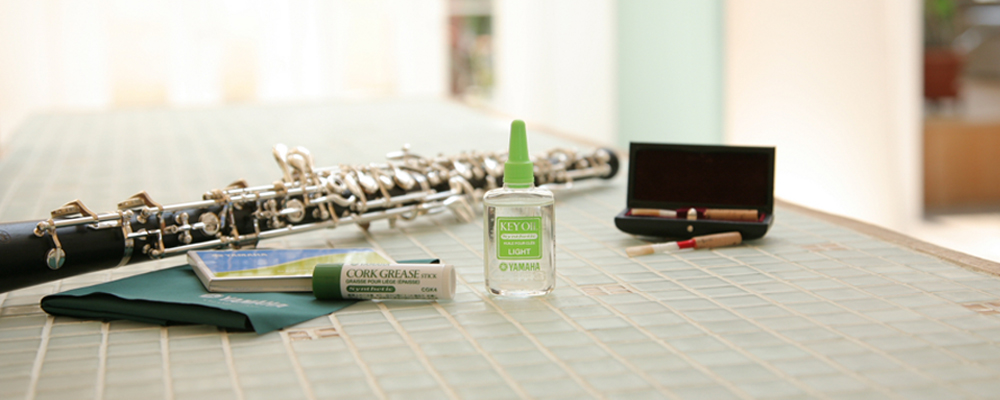Care and Maintenance of an Oboe
Basic care and maintenance
Pay attention to this first!
Because oboes are made from natural wood, they are sensitive to rapid changes in temperature or humidity. Not only can such sudden changes damage or crack the pipe, they sometimes cause warping that makes smooth jointing together of the instrument's parts impossible. For these reasons, you should pay attention to the following and treat your instrument with care:
- In the winter, wait until the entire instrument has become adjusted to the temperature of the room before playing.
*Rapid temperature changes may cause the instrument's keys to cease to move or lead to the pipe cracking. - Do not play new instruments for too long.
For the first two weeks, keep it to around 20 to 30 minutes per day. - Before playing, apply a small amount of cork grease to the end to prevent moisture exposure.
- Thoroughly dry the inside of the instrument's pipe after playing.
- Also thoroughly wipe away any moisture from the ends of the joint areas.
- While playing, remove any moisture from inside the pipe with a cleaning scrub during interludes as often as possible.
Get ready before performances!
Before assembling your instrument, apply cork grease to the joint cork and all around the lower portion of the reed tube. Take care not to apply excessive pressure on the keys when assembling the instrument.
Care and maintenance after playing
Cleaning the interior of the pipe
Moisture left inside the pipe may cause cracks to form. Always wipe away any moisture with a cleaning scrub after playing.
*Using Yamaha scrubs on other manufacturer's instruments may cause problems, such as jamming, due to differences in the sizes of the internal diameter of the pipe, and so forth. Pay careful attention.
Pass a cleaning scrub through the inside of the pipe to completely wipe away the moisture in it.

Care and maintenance of the outside surface
Lightly wipe down the outside of the instrument using a polishing cloth.
Care and maintenance of the keys
Wipe down the keys using a polishing cloth or silk cloth.
Remove any moisture from the pads.
To clean dirt or moisture from the pads, insert cleaning paper into the gaps between the tone holes and then remove.
Take care of this monthly
Oiling the key holes
Drip a small amount of key oil between the keys and key posts. Oil coming into contact with the pads or the cork may cause problems, so do not drip too much on. Use cleaning paper to wipe away any oil that spreads where it should not.
Clean away any trash or dust using a tone hole cleaner from the spaces between the keys and the pipes and other narrow spaces.
Note: Take care that the metal part at the end of the tone hole cleaner does not damage the tone holes or other parts and does not bend the metal springs.

Advice
Instruments made from the flexible kingwood are more easily affected by moisture. Take even greater care than with a grenadilla instrument: Do not to drop the instrument or hit it against anything; carefully remove moisture from the bore with a scrub; and avoid rapid changes in temperature or moisture.
Musical Instrument Guide:Oboe Contents
Structure
How to Play
How the Instrument is Made
Choosing an Instrument
Trivia
- Why does the oboe lead the orchestra in tuning?
- Do the reeds have a front and a back?
- The keys recoil via springs!
- This is how the oboe and the cor anglais differ
- The charumera was the oboe's cousin
- You can reduce time spent breathing using circular-breathing techniques?
- The Wiener oboe that survived an existential crisis
- Oboe masterpieces: concertos
- Oboe masterpieces: chamber music
- What is the alto oboe?
- The heckelphone, which resembles the oboe
- The oboe is the bassoon's cousin

